Dress For Success: What to Wear for Winter Workouts
"There's no such thing as bad weather, only unsuitable clothing."
Triple Threat Life is an email newsletter with practical triathlon tips and mindset techniques to help everyday athletes succeed. Some installments are free. Some are for paid subscribers only. Sign up here.
As I set out for my run this morning, it was 20°F with 3 inches of freshly fallen snow blanketing the landscape. It was completely magical, and nuts, considering I live in Florida… but curious weather phenomenon isn’t the point of today’s newsletter.
As I embarked into the chilly morning air, I was reminded of this quote by Alfred Wainwright.
“There’s no such thing as bad weather, only unsuitable clothing.”- Alfred Wainwright, 1973 Coast to Coast
Wainwright was an outdoorsman known for his walking adventures. He created the Coast to Coast Walk that goes from the Irish Sea to the North Sea. His often-referenced quote suggests that the right clothing can help people enjoy the outdoors, even in less than ideal weather conditions.
And I completely agree with Alfred. It likely has to do with my own love of the outdoors and my deep-seeded aversion to treadmills…
Now, we also have to use common sense. You probably shouldn’t be running or cycling on icy roads, but you get the point. But just because it’s cold, windy, or rainy, that doesn’t mean you can’t train outdoors.
Today we discuss:
5 tips- How to dress for winter workouts
Our list of winter workout essentials
The ultimate winter workout hack- no more frozen toes!
Downloadable graphics with running/cycling gear suggestions by temperature
As I was in line at the grocery store this weekend, the checkout girl asked what we had planned. I told her we were going for a trail run. She was shocked because it was 30°F.
Everyone has their own level of cold tolerance. While folks in Florida think working out in the 20s-30s is cold, Minnesotans might think that’s downright tropical.
Regardless of where you live, it’s helpful to know a few basics about working out in winter weather. The biggest mistake most people make isn’t underdressing, but overdressing. Here’s why.
Sweat + cold air = rapid heat loss
As the body heats up and the blood starts pumping, you start to sweat. If you’re wearing too much clothing, the base layer will get wet and that moisture will pull heat away from your skin. This effect is exacerbated if there’s wind.
Wet clothing also loses the ability to retain heat when damp. Even technical clothing that’s designed to wick away sweat won’t help keep you warm if you’re drenched in perspiration.
Also, damp clothing can lead to chafing (not fun) and energy drain, because your body has to work harder to regulate your temperature, expending unnecessary energy.
But if you don’t wear enough clothing you risk frozen fingers, numb toes, and ears that burn from the cold. When dressing for a winter workout, think like Goldilocks.
The key is finding the 'just right' balance of layers that keeps you warm without making you sweat, so you stay comfortable and dry.
5 tips- How to dress for winter workouts
1. If you’re warm when you start, you’re probably wearing too much clothing.
If you’re all warm and cozy when you start a bike ride or head out for a run, you’re probably wearing too much clothing. As you start moving and your blood starts pumping, this quickly becomes a problem.
The worst thing you can do in cold weather is sweat underneath your layers, so pick lightweight, breathable pieces, instead of thick, bulky apparel.
It’s much better to start out your workout feeling a bit cold, instead of overdressing which can lead to sweating.
2. Layers are your friend.
Instead of overdressing, opt for several lightweight layers.
The layer closest to your skin is a base layer. A great choice is technical wool, because it’s breathable, moisture-wicking, and provides warmth. You can also use synthetic fabrics like polyester or nylon, because they’re quick-drying. Avoid cotton because it absorbs moisture and stays wet.
The mid-layer is for insulation. Polyester fleece is lightweight and provides excellent insulation, and wool blends are great for extremely cold conditions.
That’s all I wear for running, but for cycling you probably need a protective outer layer that’s water-resistant and wind-proof. A softshell jacket is good for cold, dry conditions, while a hardshell jacket provides protection against snow and rain.
If I’m riding my bike in the 30s, I’m wearing a breathable base layer topped with a cycling jersey, vest, arm warmers, toe covers, wool socks, gloves, and a buff to keep my neck and face warm.
If I’m running in the 20s, I’m wearing a dri-fit performance shirt under a slightly thicker long-sleeve shirt, long tights, ear-warmers, gloves, and a buff.
3. Invest in lightweight packable pieces.
Before you put on a piece of clothing for a bike ride or run, think about what you’re going to do with it once you warm up. There isn’t a lot of storage on a bike, so anything you take off will need to be rolled up and stuffed inside a jersey pocket.
Don’t tie anything around your waist. That’s a recipe for disaster. This is why I like wearing a vest and arm warmers instead of a jacket, because you can easily shed those layers and pack them in a jersey pocket if you get too hot.
4. Wind chill makes a big difference.
Before heading out for a bike ride or run, we look at the temperature for the start, middle, and end of the workout. This helps us plan ahead so we know what to wear.
Also consider whether it’s sunny outside or cloudy and if there’s any wind. 30°F and sunny with no wind is going to feel a lot different than 30°F and cloudy with 15 mph wind.
If it’s very cold and a bit too windy to ride our triathlon bikes, we may opt for an off-road gravel bike ride instead, because the pace is slower and we’ll have some wind protection from trees on the trail.
5. Protect your extremities.
As long as I can wear toe covers on my cycling shoes, ear warmers, and wind resistant gloves, I can ride in just about any temperature. Your core is always going to stay warmer than your extremities, and there’s nothing worse than not being able to feel your feet during a run or having numb fingers on a bike ride.
I have a bit of Raynaud's, so my hands and feet get cold very quickly, lose feeling, and even turn purple in very cold weather. I have a pair of performance fleece gloves I wear when it’s in the 40s and a wind resistant pair I wear when it’s in the 30s. I even double up on gloves if it’s very cold.
I’m a big fan of the headband-style ear warmers from SmartWool, because they’re thin and fit underneath a helmet nicely. Also, if I get warm while running, I can pull it down to my neck or wrap around my wrist.
Another great tip is to wear a buff. You can start with it pulled up over your nose and mouth or use it as a neck-warmer. It’s also helpful for dealing with a runny nose…
Upgrade to join the Triple Threat Life Club and receive access to monthly video calls with expert guest speakers, bonus in-depth content, members-only product discounts, and $80 annual nutrition credit to the Feed.
Sidebar: It snowed in FLORIDA!!! I’m not talking about a light dusting, folks. It’s about 2-3 inches, which I’m not sure has ever happened here before. It’s incredible and we’ve taken full advantage of our Snow Day by sledding (hill repeats), building a snowman, having a snowball fight, and hiking with Ellie Mae. She loves to eat the ice…

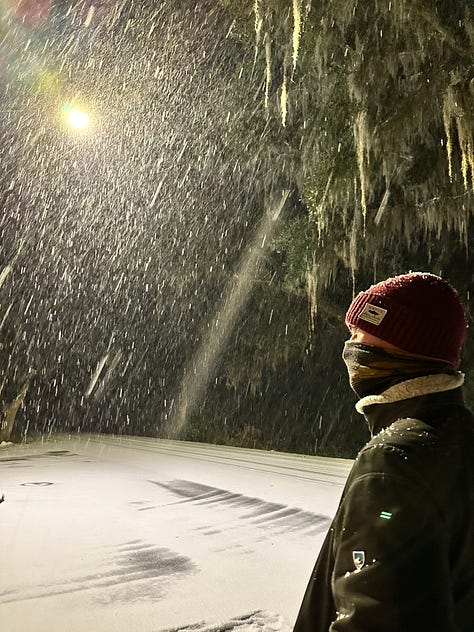
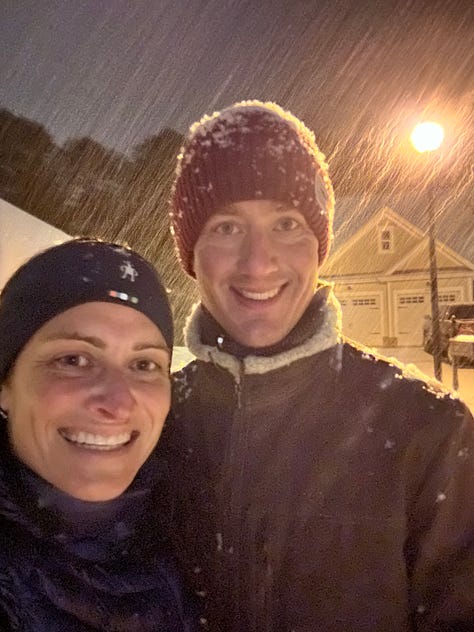
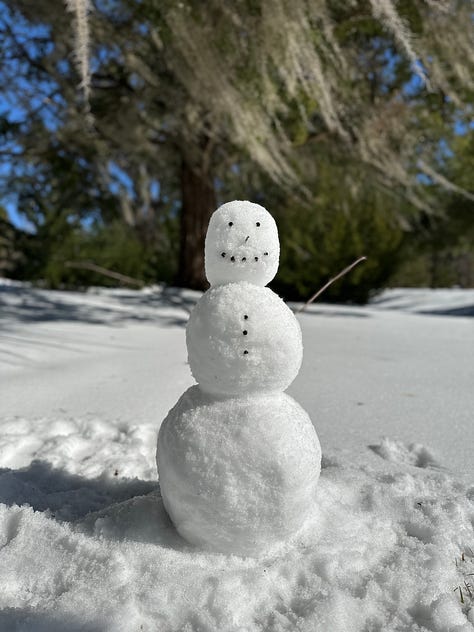
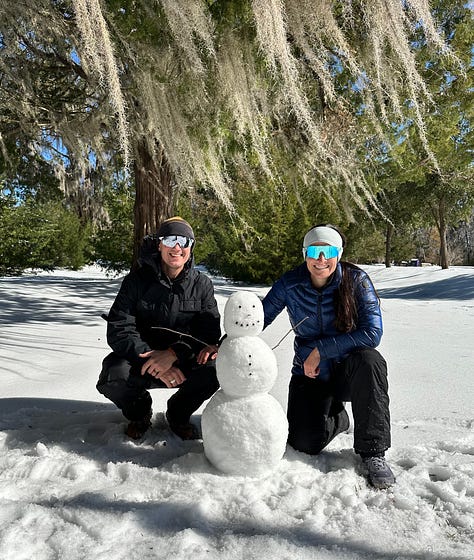
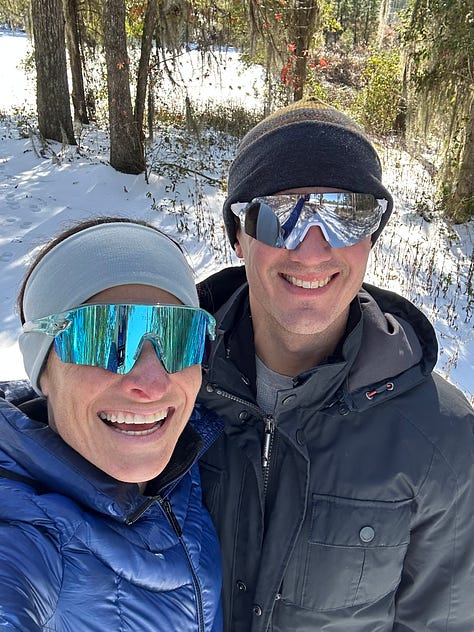

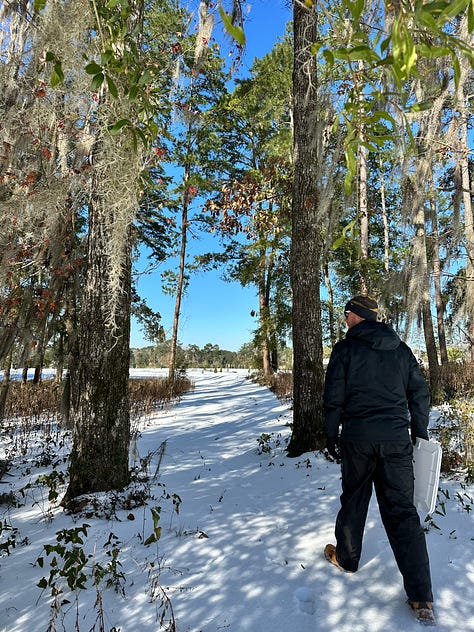
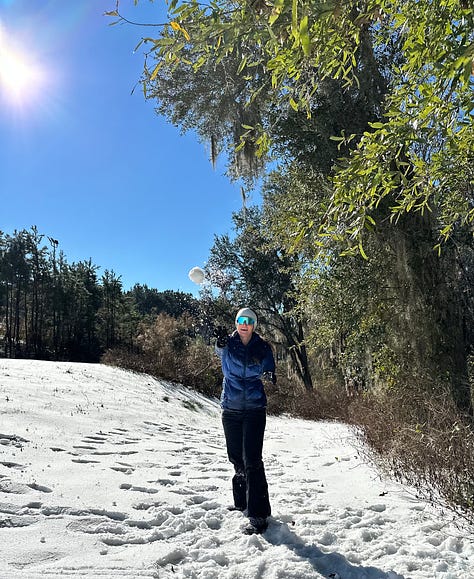
Our winter weather workout essentials
Not all gear is created equal. Here’s some of our favorite winter workout essentials.
Keep reading with a 7-day free trial
Subscribe to Triple Threat Life to keep reading this post and get 7 days of free access to the full post archives.







